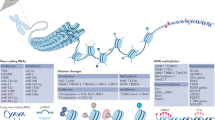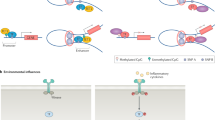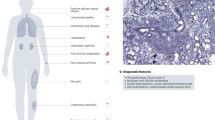Abstract
Systemic sclerosis is a connective tissue disease of unknown aetiology characterised by autoimmunity, inflammation, vascular abnormalities and ultimately fibrosis. Although great advances have been made in determining the molecular mechanisms of disease pathogenesis over the last decade, aided by new genetic screens, no current specific disease-modifying treatment is yet available. Epigenetics is defined as heritable changes that are not due to changes in DNA sequence, and there is at present intense research effort to understand the basic mechanisms of epigenetic regulation and how these impact diseases. Epigenetic modifications and dysregulation are associated now with autoimmune disease, inflammatory disease and cancer. In rheumatic diseases all three epigenetic processes are associated with various diseases including rheumatoid arthritis and systemic sclerosis. In systemic sclerosis much focus has been on microRNAs; however, other modifications including DNA methylation are emerging to have a key role. This review examines the role of epigenetics in systemic sclerosis and appraises the contribution of each modification and suggests that modulators of epigenetic changes may be a novel therapeutic option.
This is a preview of subscription content, access via your institution
Access options
Subscribe to this journal
Receive 6 digital issues and online access to articles
$119.00 per year
only $19.83 per issue
Buy this article
- Purchase on Springer Link
- Instant access to full article PDF
Prices may be subject to local taxes which are calculated during checkout


Similar content being viewed by others
References
Varga J, Abraham D . Systemic sclerosis: a prototypic multisystem fibrotic disorder. J Clin Invest 2007; 117: 557–567.
O’Reilly S, Ciechomska M, Cant R, Hügle T, van Laar JM . Interleukin-6, its role in fibrosing conditions. Cytokine Growth Factor Rev 2012; 23: 99–107.
Friedman RC, Farh KK-H, Burge CB, Bartel DP . Most mammalian mRNAs are conserved targets of microRNAs. Genome Res 2009; 19: 92–105.
Lee RC, Feinbaum RL, Ambros V . The C. elegans heterochronic gene lin-4 encodes small RNAs with antisense complementarity to lin-14. Cell 1993; 75: 843–854.
Reinhart BJ, Slack FJ, Basson M, Pasquinelli AE, Bettinger JC, Rougvie AE et al. The 21-nucleotide let-7 RNA regulates developmental timing in Caenorhabditis elegans. Nature 2000; 403: 901–906.
Han J, Lee Y, Yeom K-H, Nam J-W, Heo I, Rhee J-K et al. Molecular basis for the recognition of primary microRNAs by the Drosha-DGCR8 complex. Cell 2006; 125: 887–901.
Carthew RW, Sontheimer EJ . Origins and mechanisms of miRNAs and siRNAs. Cell 2009; 136: 642–655.
Maurer B, Stanczyk J, Jüngel A, Akhmetshina A, Trenkmann M, Brock M et al. MicroRNA-29, a key regulator of collagen expression in systemic sclerosis. Arthritis Rheum 2010; 62: 1733–1743.
Roderburg C, Urban G-W, Bettermann K, Vucur M, Zimmermann H, Schmidt S et al. Micro-RNA profiling reveals a role for miR-29 in human and murine liver fibrosis. Hepatology 2011; 53: 209–218.
Xiao J, Meng X-M, Huang XR, Chung ACK, Feng Y-L, Hui DSC et al. miR-29 inhibits bleomycin-induced pulmonary fibrosis in mice. Mol Ther 2012; 20: 1251–1260.
Kawashita Y, Jinnin M, Makino T, Kajihara I, Makino K, Honda N et al. Circulating miR-29a levels in patients with scleroderma spectrum disorder. J Dermatol Sci 2011; 61: 67–69.
Ciechomska M, O'Reilly S, Suwara MI, van Laar JM . miR29a targets TAB1 gene and regulates TIMP-1 in systemic sclerosis. Arthritis Rheum 2014, (submitted).
Pottier N, Maurin T, Chevalier B, Puisségur M-P, Lebrigand K, Robbe-Sermesant K et al. Identification of keratinocyte growth factor as a target of microRNA-155 in lung fibroblasts: implication in epithelial-mesenchymal interactions. PLoS One 2009; 4: e6718.
Makino K, Jinnin M, Kajihara I, Honda N, Sakai K, Masuguchi S et al. Circulating miR-142-3p levels in patients with systemic sclerosis. Clin Exp Dermatol 2012; 37: 34–39.
Sakoguchi A, Jinnin M, Makino T, Kajihara I, Makino K, Honda N et al. The miR-146a rs2910164 C/G polymorphism is associated with telangiectasia in systemic sclerosis. Clin Exp Dermatol 2013; 38: 99–100.
Sing T, Jinnin M, Yamane K, Honda N, Makino K, Kajihara I et al. microRNA-92a expression in the sera and dermal fibroblasts increases in patients with scleroderma. Rheumatology (Oxford) 2012; 51: 1550–1556.
Honda N, Jinnin M, Kajihara I, Makino T, Makino K, Masuguchi S et al. TGF-β–mediated downregulation of MicroRNA-196a Contributes to the constitutive upregulated type I collagen expression in scleroderma dermal fibroblasts. J Immunol 2012; 188: 3323–3331.
Kajihara I, Jinnin M, Yamane K, Makino T, Honda N, Igata T et al. Increased accumulation of extracellular thrombospondin-2 due to low degradation activity stimulates type I collagen expression in scleroderma fibroblasts. Am J Pathol 2012; 180: 703–714.
Carlson CB, Lawler J, Mosher DF . Thrombospondins: from structure to therapeutics. Cell Mol Life Sci 2008; 65: 672–686.
Etoh M, Jinnin M, Makino K, Yamane K, Nakayama W, Aoi J et al. microRNA-7 down-regulation mediates excessive collagen expression in localized scleroderma. Arch Dermatol Res 2013; 305: 9–15.
Honda N, Jinnin M, Kira-Etoh T, Makino K, Kajihara I, Makino T et al. miR-150 down-regulation contributes to the constitutive type I collagen overexpression in scleroderma dermal fibroblasts via the Induction of integrin β3. Am J Pathol 2013; 182: 206–216.
Hermann A, Gowher H, Jeltsch A . Biochemistry and biology of mammalian DNA methyltransferases. Cell Mol Life Sci 2004; 61: 2571–2587.
Li E, Bestor TH, Jaenisch R . Targeted mutation of the DNA methyltransferase gene results in embryonic lethality. Cell 1992; 69: 915–926.
Karouzakis E, Gay RE, Michel BA, Gay S, Neidhart M . DNA hypomethylation in rheumatoid arthritis synovial fibroblasts. Arthritis Rheum 2009; 60: 3613–3622.
Stanczyk J, Ospelt C, Karouzakis E, Filer A, Raza K, Kolling C et al. Altered expression of microRNA-203 in rheumatoid arthritis synovial fibroblasts and its role in fibroblast activation. Arthritis Rheum 2011; 63: 373–381.
Bechtel W, McGoohan S, Zeisberg EM, Muller GA, Kalbacher H, Salant DJ et al. Methylation determines fibroblast activation and fibrogenesis in the kidney. Nat Med 2010; 16: 544–550.
Sanders YY, Ambalavanan N, Halloran B, Zhang X, Liu H, Crossman DK et al. Altered DNA methylation profile in idiopathic pulmonary fibrosis. Am J Respir Crit Care Med 2012; 186: 525–535.
Altorok N, Tsou PS, Coit P, Khanna D, Sawalha AH . Genome-wide DNA methylation analysis in dermal fibroblasts from patients with diffuse and limited systemic sclerosis reveals common and subset-specific DNA methylation aberrancies. Ann Rheum Dis 2014, (e-pub ahead of print 8 May 2014; doi:10.1136/annrheumdis-2014-205303).
Hügle T, O'Reilly S, Simpson R, Kraaij MD, Bigley V, Collin M et al. Tumor necrosis factor co-stimulated T-lymphocytes from patients with systemic sclerosis trigger collagen production in fibroblasts. Arthritis Rheum 2013; 65: 481–491.
Lei W, Luo Y, Yan K, Zhao S, Li Y, Qiu X et al. Abnormal DNA methylation in CD4+ T cells from patients with systemic lupus erythematosus, systemic sclerosis, and dermatomyositis. Scand J Rheumatol 2009; 38: 369–374.
Lian X, Xiao R, Hu X, Kanekura T, Jiang H, Li Y et al. DNA demethylation of CD40L in CD4+ T cells from women with systemic sclerosis: a possible explanation for female susceptibility. Arthritis Rheum 2012; 64: 2338–2345.
Jiang H, Xiao R, Lian X, Kanekura T, Luo Y, Yin Y et al. Demethylation of TNFSF7 contributes to CD70 overexpression in CD4+ T cells from patients with systemic sclerosis. Clin Immunol 2012; 143: 39–44.
Selmi C, Feghali-Bostwick CA, Lleo A, Lombardi SA, De Santis M, Cavaciocchi F et al. X chromosome gene methylation in peripheral lymphocytes from monozygotic twins discordant for scleroderma. Clin Exp Immunol 2012; 169: 253–262.
Dees C, Schlottmann I, Funke R, Distler A, Palumbo-Zerr K, Zerr P et al. The Wnt antagonists DKK1 and SFRP1 are downregulated by promoter hypermethylation in systemic sclerosis. Ann Rheum Dis 2014; 73: 1232–1239.
Akhmetshina A, Palumbo K, Dees C, Bergmann C, Venalis P, Zerr P et al. Activation of canonical Wnt signalling is required for TGF-β-mediated fibrosis. Nat Commun 2012; 3: 735.
Wang Y, Fan P-S, Kahaleh B . Association between enhanced type I collagen expression and epigenetic repression of the FLI1 gene in scleroderma fibroblasts. Arthritis Rheum 2006; 54: 2271–2279.
Watson CJ, Collier P, Tea I, Neary R, Watson JA, Robinson C et al. Hypoxia-induced epigenetic modifications are associated with cardiac tissue fibrosis and the development of a myofibroblast-like phenotype. Hum Mol Genet 2014; 23: 2176–2188.
Lin HS, Hu CY, Chan HY, Liew YY, Huang HP, Lepescheux L et al. Anti-rheumatic activities of histone deacetylase (HDAC) inhibitors in vivo in collagen-induced arthritis in rodents. Br J Pharmacol 2007; 150: 862–872.
Grabiec AM, Korchynskyi O, Tak PP, Reedquist KA . Histone deacetylase inhibitors suppress rheumatoid arthritis fibroblast-like synoviocyte and macrophage IL-6 production by accelerating mRNA decay. Ann Rheum Dis 2012; 71: 424–431.
Rombouts K, Niki T, Greenwel P, Vandermonde A, Wielant A, Hellemans K et al. Trichostatin A, a histone deacetylase inhibitor, suppresses collagen synthesis and prevents TGF-β1-induced fibrogenesis in skin fibroblasts. Exp Cell Res 2002; 278: 184–197.
Ghosh AK, Mori Y, Dowling E, Varga J . Trichostatin A blocks TGF-β-induced collagen gene expression in skin fibroblasts: involvement of Sp1. Biochem Biophys Res Commun 2007; 354: 420–426.
Huber LC, Distler JHW, Moritz F, Hemmatazad H, Hauser T, Michel BA et al. Trichostatin A prevents the accumulation of extracellular matrix in a mouse model of bleomycin-induced skin fibrosis. Arthritis Rheum 2007; 56: 2755–2764.
Hemmatazad H, Rodrigues HM, Maurer B, Brentano F, Pileckyte M, Distler JHW et al. Histone deacetylase 7, a potential target for the antifibrotic treatment of systemic sclerosis. Arthritis Rheum 2009; 60: 1519–1529.
Krämer M, Dees C, Huang J, Schlottmann I, Palumbo-Zerr K, Zerr P et al. Inhibition of H3K27 histone trimethylation activates fibroblasts and induces fibrosis. Ann Rheum Dis 2013; 72: 614–620.
Zhou Q, Chung AC, Huang XR, Dong Y, Yu X, Lan HY . Identification of novel long noncoding RNAs associated with TGF-beta/Smad3-mediated renal inflammation and fibrosis by RNA sequencing. Am J Pathol 2014; 184: 409–417.
Song X, Cao G, Jing L, Lin S, Wang X, Zhang J et al. Analysing the relationship between lncRNA and protein-coding gene and the role of lncRNA as ceRNA in pulmonary fibrosis. J Cell Mol Med 2014, (e-pub ahead of print 6 April 2014; doi:10.1111/jcmm.12243).
Janssen HLA, Reesink HW, Lawitz EJ, Zeuzem S, Rodriguez-Torres M, Patel K et al. Treatment of HCV infection by targeting microRNA. New Engl J Med 2013; 368: 1685–1694.
Liu N, He S, Ma L, Ponnusamy M, Tang J, Tolbert E et al. Blocking the class I histone deacetylase ameliorates renal fibrosis and inhibits renal fibroblast activation via modulating TGF-beta and EGFR signaling. PLoS ONE 2013; 8: e54001.
Zeybel M, Hardy T, Wong YK, Mathers JC, Fox CR, Gackowska A et al. Multigenerational epigenetic adaptation of the hepatic wound-healing response. Nat Med 2012; 18: 1369–1377.
Khan O, La Thangue NB . HDAC inhibitors in cancer biology: emerging mechanisms and clinical applications. Immunol Cell Biol 2012; 90: 85–94.
Garcia-Manero G, Yang H, Bueso-Ramos C, Ferrajoli A, Cortes J, Wierda WG et al. Phase 1 study of the histone deacetylase inhibitor vorinostat (suberoylanilide hydroxamic acid [SAHA]) in patients with advanced leukemias and myelodysplastic syndromes. Blood 2008; 111: 1060–1066.
Kirschbaum MH, Foon KA, Frankel P, Ruel C, Pulone B, Tuscano JM et al. A phase 2 study of belinostat (PXD101) in patients with relapsed or refractory acute myeloid leukemia or patients over the age of 60 with newly diagnosed acute myeloid leukemia: a California Cancer Consortium Study. Leuk Lymphoma 2014, (e-pub ahead of print 24 February 2014; doi:10.3109/10428194.2013.877134).
Yeo W, Chung HC, Chan SL, Wang LZ, Lim R, Picus J et al. Epigenetic therapy using belinostat for patients with unresectable hepatocellular carcinoma: a multicenter phase I/II study with biomarker and pharmacokinetic analysis of tumors from patients in the Mayo Phase II Consortium and the Cancer Therapeutics Research Group. J Clin Oncol 2012; 30: 3361–3367.
Dizon DS, Damstrup L, Finkler NJ, Lassen U, Celano P, Glasspool R et al. Phase II activity of belinostat (PXD-101), carboplatin, and paclitaxel in women with previously treated ovarian cancer. Int J Gynecol Cancer 2012; 22: 979–986.
Mascarenhas J, Lu M, Li T, Petersen B, Hochman T, Najfeld V et al. A phase I study of panobinostat (LBH589) in patients with primary myelofibrosis (PMF) and post-polycythaemia vera/essential thrombocythaemia myelofibrosis (post-PV/ET MF). Br J Haematol 2013; 161: 68–75.
DeAngelo DJ, Mesa RA, Fiskus W, Tefferi A, Paley C, Wadleigh M et al. Phase II trial of panobinostat, an oral pan-deacetylase inhibitor in patients with primary myelofibrosis, post-essential thrombocythaemia, and post-polycythaemia vera myelofibrosis. Br J Haematol 2013; 162: 326–335.
Rodriguez-Paredes M, Esteller M . Cancer epigenetics reaches mainstream oncology. Nat Med 2011; 17: 330–339.
Yardley DA, Ismail-Khan RR, Melichar B, Lichinitser M, Munster PN, Klein PM et al. Randomized phase II, double-blind, placebo-controlled study of exemestane with or without entinostat in postmenopausal women with locally recurrent or metastatic estrogen receptor-positive breast cancer progressing on treatment with a nonsteroidal aromatase inhibitor. J Clin Oncol 2013; 31: 2128–2135.
Spigel DR, Burris HA 3rd, Greco FA, Shipley DL, Friedman EK, Waterhouse DM et al. Randomized, double-blind, placebo-controlled, phase II trial of sorafenib and erlotinib or erlotinib alone in previously treated advanced non-small-cell lung cancer. J Clin Oncol 2011; 29: 2582–2589.
Pili R, Salumbides B, Zhao M, Altiok S, Qian D, Zwiebel J et al. Phase I study of the histone deacetylase inhibitor entinostat in combination with 13-cis retinoic acid in patients with solid tumours. Br J Cancer 2012; 106: 77–84.
Haigentz M Jr, Kim M, Sarta C, Lin J, Keresztes RS, Culliney B et al. Phase II trial of the histone deacetylase inhibitor romidepsin in patients with recurrent/metastatic head and neck cancer. Oral Oncol 2012; 48: 1281–1288.
Iwamoto FM, Lamborn KR, Kuhn JG, Wen PY, Yung WK, Gilbert MR et al. A phase I/II trial of the histone deacetylase inhibitor romidepsin for adults with recurrent malignant glioma: North American Brain Tumor Consortium Study 03-03. Neuro Oncol 2011; 13: 509–516.
Raffoux E, Cras A, Recher C, Boelle PY, de Labarthe A, Turlure P et al. Phase 2 clinical trial of 5-azacitidine, valproic acid, and all-trans retinoic acid in patients with high-risk acute myeloid leukemia or myelodysplastic syndrome. Oncotarget 2010; 1: 34–42.
Chu BF, Karpenko MJ, Liu Z, Aimiuwu J, Villalona-Calero MA, Chan KK et al. Phase I study of 5-aza-2'-deoxycytidine in combination with valproic acid in non-small-cell lung cancer. Cancer Chemother Pharmacol 2013; 71: 115–121.
Wheler JJ, Janku F, Falchook GS, Jackson TL, Fu S, Naing A et al. Phase I study of anti-VEGF monoclonal antibody bevacizumab and histone deacetylase inhibitor valproic acid in patients with advanced cancers. Cancer Chemother Pharmacol 2014; 73: 495–501.
Reid T, Valone F, Lipera W, Irwin D, Paroly W, Natale R et al. Phase II trial of the histone deacetylase inhibitor pivaloyloxymethyl butyrate (Pivanex, AN-9) in advanced non-small cell lung cancer. Lung Cancer 2004; 45: 381–386.
Author information
Authors and Affiliations
Corresponding author
Ethics declarations
Competing interests
The authors declare no conflict of interest.
Rights and permissions
About this article
Cite this article
Ciechomska, M., van Laar, J. & O'Reilly, S. Emerging role of epigenetics in systemic sclerosis pathogenesis. Genes Immun 15, 433–439 (2014). https://doi.org/10.1038/gene.2014.44
Received:
Revised:
Accepted:
Published:
Issue Date:
DOI: https://doi.org/10.1038/gene.2014.44
This article is cited by
-
Anti-fibrotic effect of a selective estrogen receptor modulator in systemic sclerosis
Stem Cell Research & Therapy (2022)
-
Mesenchymal stem cell transplantation in tight-skin mice identifies miR-151-5p as a therapeutic target for systemic sclerosis
Cell Research (2017)
-
Innate Immunity in Systemic Sclerosis
Current Rheumatology Reports (2017)
-
IL-13 mediates collagen deposition via STAT6 and microRNA-135b: a role for epigenetics
Scientific Reports (2016)
-
Global DNA methylation changes and differential gene expression in Anaplasma phagocytophilum-infected human neutrophils
Clinical Epigenetics (2015)



